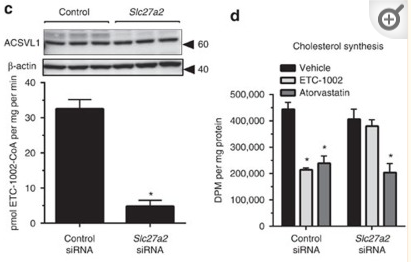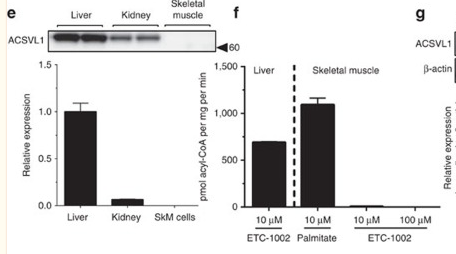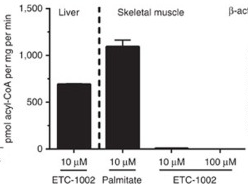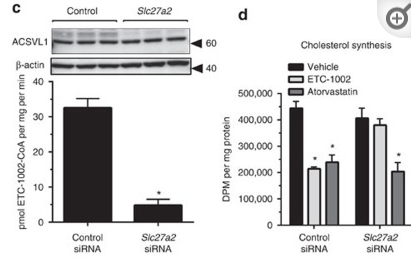A_User
#2342
I don’t think ACSL3 and ACSL4 is used because silencing Slc27a2 to decrease Slc27a2 protein levels by 80% reduces Bempedoyl-CoA by 85%, and also the cholesterol synthesis barely moved. What do you think of this?
To establish that ACSVL1 was the specific ACS isoform that catalyses the CoA activation of ETC-1002 we used small-interfering ribonucleic acid (siRNA)-mediated gene silencing in McArdle cells. ACSVL1 (Slc27a2) siRNA treatment reduced protein levels by more than 80%, which was associated with an 85% reduction in ETC-1002-CoA formation (Fig. 2c). Importantly, ACSVL1 gene silencing blocked ETC-1002 but not atorvastatin-dependent inhibition of de novo cholesterol synthesis, thus establishing the high specificity of ACSVL1 for the CoA activation of ETC-1002 (Fig. 2d).

That fits with the idea that ACSVL1 is expressed to a greater extent than ACSL3 and ACSL4. What we don’t know is the extent to which ACSL3 and 4 are expressed in liver cells. They were using McArdle cells-RH7777.
A_User
#2344
In contrast to observations in liver microsomes, where ACSVL1 was highly expressed, the absence of ACSVL1 in human skeletal muscle corresponded to a lack of ETC-1002-CoA synthetase activity (Fig. 2f); however, CoA activation of palmitate was still observed in human skeletal microsomes indicating the activity of other ACS isoforms was present (Fig. 2f).

Despite other ACS isoforms in human skeletal muscle, as shown by the CoA activation of palmitate, there was no CoA activation of bempedoic acid. That should prove that ACSVL1 is required.
A_User
#2345
@John_Hemming do you concur that ACSVL1 is required based on this evidence?
The difficulty is that there are a number of Isoforms.
palmitoyl-coenzyme A synthetase is ACSL1 and I was referring to ACSL3 and 4.
https://www.genecards.org/cgi-bin/carddisp.pl?gene=ACSL1
Looking at the Gene Cards ACSL1 tends to go for things like Palmitate with 16 carbons and ACSL4 goes for Arachidonate which is 20 carbons (one more than Bempedoic)
A_User
#2347
There is a lot of ACSL4 expression in skeletal muscle, a reaction of pamitate showed the microsomes were functioning.
ACSL4:
For ACSL3, the liver has more expression than the prostate:
Comparison with SLC27A5:
What do you think of this?
From proteinatlas.
Thank you for the response. This is from the article in the recent Neurology journal: This prospective longitudinal study used data from the ASPREE randomized trial of adults aged ≥65 years without dementia or previous cardiovascular events at enrolment. The main outcome was incident dementia. Other outcomes included changes in composite cognition and domain-specific cognition (global cognition, memory, language and executive function, and psychomotor speed). The association between baseline triglycerides and dementia risk was estimated using Cox proportional-hazard models adjusting for relevant risk factors. Linear mixed models were used to investigate cognitive change. The analysis was repeated in a sub-cohort of participants with available APOE -ε4 genetic data with additional adjustment for APOE -ε4 carrier status, and an external cohort (UK Biobank) with similar selection criteria applied.
The included population did not have dementia or other neurological problems at the onset of the study.
I am also confused about the high HDL, not only low triglycerides, being associated with increased dementia risk.
1 Like
The issue is a question of comparing the substrate of ACSL1 and 4. I will however go to sleep soon and not respond further for some time.
A_User
#2350
What do you mean with substrate? It was skeletal muscle - no increase in CoA of bempedoic acid despite ACSL3 and ACSL4 having expression there, as evident by proteinatlas which is consistent with liver expression of SLC27A5.
A_User
#2351
I did not find this information in the article, but you are probably right: lowering of LDL most of the time is associated with elevated HDL. The whole thing about correlation of low triglycerides and high HDL with increased incidence of dementia is most likely incorrect, at least according to Pubmed information.
A_User
#2353
It is apparently taboo to talk about HDL since they don’t seem to mention a lot on their website, but the drug increases HDL by 165%.
See the story here about how HDL (ApoA1) could possibly help with Alzheimer’s disease especially for APOE4 allele carriers:
https://www.newamsterdampharma.com/therapeutic-areas#alzheimers
2 Likes
In the end, however, the chart you cite has a small expression of SLC27A5 in the prostate so the question as whether or not ACSL3 or 4 have any effect is moot.
A_User
#2355
So do you agree now that SLC27A5 is required?
Just wondering so I can know if we have discussed specifically about this enough and I can think about other downsides with bempedoic acid.
Was that enough evidence?
I agree that there is an argument that SLC27A5 is required. My main point was that there appears to be active bempedoic acid in the prostate and if SLC27A5 is expressed that would be a logical mechanism.
To what extent either ACSL3 and 4 are able to metabolise bempedoic acid does not seem to be completely proven, but it does not matter.
What I was concerned about is that there appears to be some BA active in tissues other than the liver (even if at a much lower level) and indeed that fits with the expression bar chart.
It raises an interesting question as to the effect on ACM as the benefit from reducing LDL-C is on one side of the equation, but the (slight) damage to mRNA transcription is on the other side of the equation.
Personally I would much prefer a statin (and have tried two different ones on separate occasions.).
A_User
#2357
You can see that skeletal muscle also has about the same expression of SLC27a5 as the prostate and there was ~0 bempedoic-CoA in skeletal muscle. This suggests that there is similarly ~0 bempedoic-CoA in the prostate.
Would you agree with this?
That suggests another hypothesis about the prostate, like one I mentioned earlier.
scta123
#2358
Ezetimibe is more appropriate strategy to lower LDL-C if you are “over-absorber” of cholesterol but it has a similar effect as adding soluble fiber to your diet (I forgot the particular amount in studies, but I believe it was a small amount, around 10-15 g/daily). Same effect would be expected from a high fiber diet. Reduction would be expected from 10 to 30%, depending on your cholesterol reabsorption in your gut. IMO dietary strategy has more sense.
1 Like
The point about bempedoic-CoA is very little of it is needed to impact on acetyl-CoA production.
We clearly know that SLC27A5 converts Bempedoic Acid to b-CoA. It may also be the case that ACSL3 and 4 do this.
Hence the presence of SLC27A5 is key.
A lot level of inhibition can have a lot of any effect and this can vary by individual.
I think the position is clear ~0≠0
A_User
#2360
If we compare the amount of bempedoic-CoA in the liver compared to skeletal muscle which is a proxy for the prostate, it is about 700 times less:

Do you think that 700 times less bempedoic-CoA will have an effect on acetyl-CoA production?
For comparison, a 85% reduction in bempedoic-CoA made the cholesterol synthesis barely move

Obviously it would have an effect. The question is what impact the effect has on broader issues. It could have a greater and lesser effect in different people. In some people it could cause prostate problems.
I think we have an agreement on some of the facts viz that in the prostate you would expect a small amount of bempedoyl-CoA.
It does not really matter whether this comes from SLC27A5 or ASCL3 or 4.
Unsurprisingly I have spent a lot of time looking at the issue of the movement of citrate from serum into cells. There are a number of transports, but in fact even in cells without a known transport a small amount of citrate gets from serum into the cells. Hence we don’t really know without testing levels in the right tissue probably in vivo in a different number of individuals.
Small amounts of things can have an effect.
Thank you for making me work, however.
1 Like